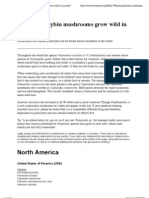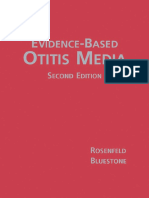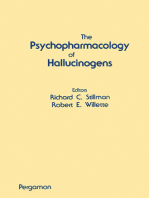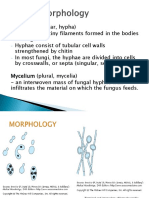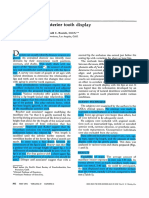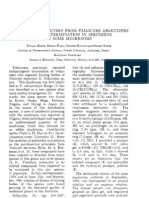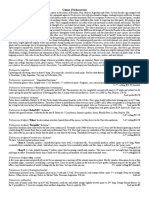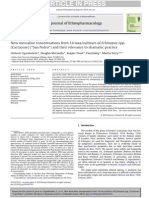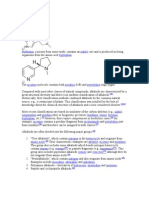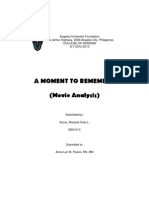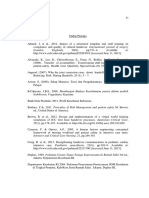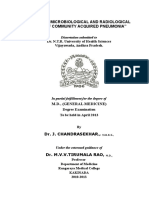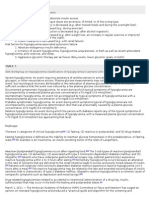Professional Documents
Culture Documents
Psilocybe Semilanceata
Uploaded by
DánielCsörfölyOriginal Description:
Original Title
Copyright
Available Formats
Share this document
Did you find this document useful?
Is this content inappropriate?
Report this DocumentCopyright:
Available Formats
Psilocybe Semilanceata
Uploaded by
DánielCsörfölyCopyright:
Available Formats
Psilocybe semilanceata
Psilocybe semilanceata, commonly known as the liberty cap, is a psychedelic (or magic) mushroom that
contains the psychoactive compounds psilocybin and
baeocystin. Of the worlds psilocybin mushrooms, it is the
most common in nature, and one of the most potent. The
mushrooms have a distinctive conical to bell-shaped cap,
up to 2.5 cm (1.0 in) in diameter, with a small nipple-like
protrusion on the top. They are yellow to brown, covered
with radial grooves when moist, and fade to a lighter color
as they mature. Their stipes tend to be slender and long,
and the same color or slightly lighter than the cap. The gill
attachment to the stipe is adnexed (narrowly attached),
and they are initially cream-colored before tinting purple
as the spores mature. The spores are dark purplish-brown
in mass, ellipsoid in shape, and measure 10.515 by 6.5
8.5 micrometers.
in 1887 (originally named Agaricus semilanceatus var.
coerulescens by Mordecai Cubitt Cooke in 1881),[8] the
microspora variety described by Rolf Singer in 1969,[9]
and the obtusata variety described by Marcel Bon in
1985.[10]
The mushroom grows in elds, grassy meadows, and
similar habitats, particularly in wet, north-facing elds
(south-facing for southern hemisphere) that are wellfertilized by sheep and cattle feces. But unlike P. cubensis, the fungus does not grow directly on dung; rather, it is
a saprobic species that feeds o decaying grass roots. It
is widely distributed in the cool temperate and subarctic
regions of the Northern Hemisphere, particularly in Europe. However, it has also been reported occasionally
from warmer locations such as India, South America,
and Australasia. The earliest reliable history of P. semilanceata intoxication dates back to 1799 in London, and
in the 1960s the mushroom was the rst European species
conrmed to contain psilocybin. Further investigations
into the chemical makeup of the fungus revealed the
presence of the substances phenylethylamine, and the
psychotropic tryptamine baeocystin. The possession or
sale of psilocybin mushrooms is illegal in many countries.
The mushroom gets its common name from its resemblance to the Phrygian cap.
Several molecular studies published in the 2000s (decade)
demonstrated that Psilocybe, as it was dened then,
was polyphyletic.[11][12][13] The studies supported the
idea of dividing the genus into two clades, one consisting of the bluing, hallucinogenic species in the family Hymenogastraceae, and the other the non-bluing,
non-hallucinogenic species in the family Strophariaceae.
However, the generally accepted lectotype (a specimen later selected when the original author of a taxon
name did not designate a type) of the genus as a
whole was Psilocybe montana, which is a non-bluing,
non-hallucinogenic species. If the non-bluing, nonhallucinogenic species in the study were to be segregated,
it would have left the hallucinogenic clade without a valid
name. To resolve this dilemma, several mycologists proposed in a 2005 publication to conserve the name Psilocybe, with P. semilanceata as the type. As they explained,
conserving the name Psilocybe in this way would prevent
nomenclatural changes to a well-known group of fungi,
many species of which are linked to archaeology, anthropology, religion, alternate life styles, forensic science,
law enforcement, laws and regulation.[14] Further, the
name P. semilanceata had historically been accepted as
the lectotype by many authors in the period 193868.
The proposal to conserve the name Psilocybe, with P.
semilanceata as the type was accepted unanimously by
Taxonomy and naming
The species was rst described by Elias Magnus Fries
as Agaricus semilanceatus in his 1838 Epicrisis Systematis Mycologici.[3] Paul Kummer transferred it to Psilocybe
in 1871 when he raised many of Friess sub-groupings
of Agaricus to the level of genus.[4] Panaeolus semilanceatus, named by Jakob Emanuel Lange in both 1936
and 1939 publications, is a synonym.[5][6] According to
the taxonomical database MycoBank, several taxa once
considered varieties of P. semilanceata are synonymous
with the species now known as Psilocybe strictipes:[7] the
caerulescens variety described by Pier Andrea Saccardo
1
the Nomenclature Committee for Fungi in 2009.[15]
The mushroom takes its common name from the
Phrygian cap, also known as the liberty cap, which it
resembles;[16] P. semilanceata shares its common name
with P. pelliculosa,[17] a species from which it is more or
less indistinguishable in appearance.[18] The Latin word
for Phrygian cap is pileus, nowadays the technical name
for what is commonly known as the cap of a fungal fruit
body. In the 18th century Phrygian caps were placed on
Liberty poles, which resemble the stipe of the mushroom.
The generic name is derived from the Ancient Greek psilos () (smooth or bare) and the Byzantine Greek
kub () (head).[19][20] The specic epithet comes
from the Latin semi (half) and lanceata, from lanceolatus, meaning spear-shaped.[21]
DESCRIPTION
tween 15 and 27 individual narrow gills that are moderately crowded together, and they have a narrowly adnexed
to almost free attachment to the stipe. Their color is initially pale brown, but becomes dark gray to purple-brown
with a lighter edge as the spores mature. The slender
yellowish-brown stipe is 45140 mm (1.85.5 in) long
by 13.5 mm (0.040.14 in) thick, and usually slightly
thicker towards the base.[2] The mushroom has a thin
cobweb-like partial veil that does not last long before disappearing; sometimes, the partial veil leaves an annular
zone on the stipe that may be darkened by spores.[22] The
esh is thin and membrane-like, and roughly the same
color as the surface tissue. It has a farinaceous (similar
to freshly ground our) odor and taste. All parts of the
mushroom will stain a bluish color if handled or bruised,
and it may naturally turn blue with age.[2]
Description
Microscopic characteristics
A collection from The Netherlands
The cap of P. semilanceata is 525 mm (0.21.0 in) in
diameter and 622 mm (0.240.87 in) tall. It varies in
shape from sharply conical to bell-shaped, often with a
prominent papilla (a nipple-shaped structure), and does
not change shape considerably as it ages. The cap
margin is initially rolled inward but unrolls to become
straight or even curled upwards in maturity. The cap is
hygrophanous, meaning it assumes dierent colors depending on its state of hydration. When it is moist, the
cap is ochraceous to pale brown to dark chestnut brown,
but darker in the center, often with a greenish-blue tinge.
When moist, radial grooves (striations) can be seen on
the cap that correspond to the positions of the gills underneath. When the cap is dry, it becomes much paler, a
light yellow-brown color.[2] Moist mushrooms have sticky
surfaces that result from a thin gelatinous lm called a
pellicle.[22] This lm becomes apparent if a piece of the
cap is broken by bending it back and peeling away the
piece. When the cap dries from exposure to the sun, the
lm turns whitish and is no longer peelable.[23]
2.1 Microscopic characteristics
In deposit, the spores are a deep reddish purple-brown
color. The use of a light microscope can reveal further
details: the spores are oblong when seen in side view, and
oblong to oval in frontal view, with dimensions of 10.5
15 by 6.58.5 m. The basidia (spore bearing cells of the
hymenium), are 2031 by 59 m, four-spored, and have
clamps at their bases; there are no basidia found on the
sterile gill edge. The cheilocystidia (cystidia on the gill
edge) measure 1530 by 47 m, and are ask-shaped
with long thin necks that are 13.5 m wide. P. semilanceata does not have pleurocystidia (cystidia on the gill
face). The cap cuticle is up to 90 m thick, and is made
of a tissue layer called an ixocutisa gelatinized layer
of hyphae lying parallel to the cap surface. The hyphae
comprising the ixocutis are cylindrical, hyaline, and 1
3.5 m wide. Immediately under the cap cuticle is the
subpellis, made of hyphae that are 412 m wide with
yellowish-brown encrusted walls. There are clamp conOn the underside of the mushrooms cap, there are be- nections present in the hyphae of all tissues.[2]
2.2
Other forms
The anamorphic form of P. semilanceata is an asexual
stage in the funguss life cycle involved in the development of mitotic diaspores (conidia). In culture, grown in
a petri dish, the fungus forms a white to pale orange cottony or felt-like mat of mycelia. The conidia formed are
straight to curved, measuring 2.08.0 by 1.12.0 m, and
may contain one to several small intracellular droplets.[24]
Although little is known of the anamorphic stage of P.
semilanceata beyond the connes of laboratory culture,
in general, the morphology of the asexual structures may
be used as classical characters in phylogenetic analyses
to help understand the evolutionary relationships between
related groups of fungi.[25]
Lookalikes include P. mexicana (left), P. pelliculosa
(center), and P. strictipes (right).
There are several other Psilocybe species that may be confused with P. semilanceata due to similarities in physical
appearance. P. strictipes is a slender grassland species that
is dierentiated macroscopically from P. semilanceata by
the lack of a prominent papilla. P. mexicana, commonly
known as the Mexican liberty cap, is also similar in appearance, but is found in manure-rich soil in subtropical
grasslands in Mexico. It has somewhat smaller spores
than P. semilanceata, typically 89.9 by 5.57.7 m.[27]
Another lookalike species is P. samuiensis, found in Thailand, where it grows in well-manured clay-like soils or
among rice paddies. This mushroom can be distinguished
from P. semilanceata by its smaller cap, up to 1.5 cm (0.6
in) in diameter, and its rhomboid-shaped spores.[28] P.
pelliculosa is physically similar to such a degree that it
may be indistinguishable in the eld. It diers from P.
semilanceata by virtue of its smaller spores, measuring
913 by 57 m.[18]
Scottish mycologist Roy Watling described sequestrate
(true-like) or secotioid versions of P. semilanceata he
found growing in association with regular fruit bodies.
These versions had elongated caps, 2022 cm (7.98.7
in) long and 0.81 cm (0.30.4 in) wide at the base,
with the inward curved margins closely hugging the stipe
from the development of membranous anges. Their gills
were narrow, closely crowded together, and anastomosed
(fused together in a vein-like network). The color of
the gills was sepia with a brownish vinaceous (red winecolored) cast, and a white margin. The stipes of the fruit
bodies were 56 cm (2.02.4 in) long by 0.10.3 cm
(0.040.12 in) thick, with about 2 cm (0.8 in) of stipe
length covered by the extended cap. The thick-walled ellipsoid spores were 12.513.5 by 6.57 m. Despite the
signicant dierences in morphology, molecular analysis
showed the secotioid version to be the same species as the The toxic species Cortinarius rubellus (formerly known
as C. orellanoides)[29] has been confused with P. semitypical morphotype.[26]
lanceata by novice collectors looking to consume the
mushrooms for hallucinogenic eects, sometimes with
drastic consequences.[30] The expanded and bluntly
umbonate cap of C. rubellus is orange-brown with a
3 Similar species
larger diameter than P. semilanceata, typically ranging from 26 cm (0.82.4 in). The gills are adnate
to sinuate in attachment to the stipe, and cinnamonbrown in color (rather than dark gray to purple-brown).
Its stipe is roughly the same color as the cap, 58
cm (2.03.1 in) long and much thicker than P. semilanceatausually 0.61 cm (0.20.4 in), and sometimes bears lemon-yellow bands. It is a mycorrhizal
species that grows on acidic soil among mosses, usually in wet coniferous forests.[31] P. semilanceata has
also been confused with the toxic muscarine-containing
species Inocybe geophylla,[32] a whitish mushroom with a
silky cap, yellowish-brown to pale grayish gills, and a dull
yellowish-brown spore print.[33]
4 Ecology and habitat
Psilocybe semilanceata is a saprobic fungus, meaning it
obtains nutrients by breaking down organic matter. The
PSYCHOACTIVE USE
5 Distribution
Psilocybe semilanceata is considered the most common
psilocybin-containing mushroom.[32] In Europe, P. semilanceata has a widespread distribution, and is found in
Austria, Belarus, Belgium, Bulgaria, the Channel Islands,
Czech republic, Denmark, Estonia, the Faroe Islands,
Finland, France, Germany, Georgia, Hungary, Iceland,
Ireland, Italy, Latvia, Lithuania, the Netherlands, Norway, Poland, Romania, Russia, Slovakia, Spain, Sweden,
Switzerland and the United Kingdom.[40] It is generally
agreed that the species is native to Europe;[41] Watling has
demonstrated that there exists little dierence between
specimens collected from Spain and Scotland, at both the
morphological and genetic level.[26]
Psilocybe semilanceata is a saprobic grassland species.
mushroom grows solitarily or in groups on the ground,
typically in elds and pastures. It is often found in elds
that have been fertilized with sheep or cow dung, although
it does not typically grow directly on the dung. The mushroom is also associated with sedges in moist areas of
elds,[22] and it is thought to live on the decaying root
remains.[34][35] Like some other grassland species such as
P. mexicana, P. tampanensis and Conocybe cyanopus, P.
semilanceata may form sclerotia, a dormant form of the
fungus, which aords it some protection from wildres
and other natural disasters.[36]
Laboratory tests have shown P. semilanceata to suppress
the growth of the soil-borne water mold Phytophthora cinnamomi, a virulent plant pathogen that causes the disease
root rot.[37] When grown in dual culture with other saprobic fungi isolated from the rhizosphere of grasses from
its habitat, P. semilanceata signicantly suppresses their
growth. This antifungal activity, which can be traced at
least partly to two phenolic compounds it secretes, helps
it compete successfully with other fungal species in the
intense competition for nutrients provided by decaying
plant matter.[38] Using standard antimicrobial susceptibility tests, Psilocybe semilanceata was shown to strongly
inhibit the growth of the human pathogen methicillinresistant Staphylococcus aureus (MRSA). The source of
the antimicrobial activity is unknown.[39]
The mushroom also has a widespread distribution in
North America. In Canada it has been collected from
British Columbia, New Brunswick, Newfoundland, Nova
Scotia, Prince Edward Island and Quebec.[40] In the
United States, it is most common in the Pacic Northwest, west of the Cascade Mountains, where it fruits
abundantly in autumn and early winter; fruiting has
also been reported to occur infrequently during spring
months.[22] Charles Horton Peck reported the mushroom
to occur in New York in the early 20th century, and consequently, much literature published since then has reported the species to be present in the eastern United
States. Gaston Guzman later examined Pecks herbarium
specimen, and in his comprehensive 1983 monograph on
Psilocybe, concluded that Peck had misidentied it with
the species now known as Panaeolina foenisecii.[41][42] P.
semilanceata is much less common in South America,[41]
where it has been recorded from southern Brazil, Argentina, Uruguay and Chile.[40] It is also known in Australia (where it may be an introduced species)[26] and New
Zealand, where it grows in high-altitude grasslands.[43] In
2000, it was reported from Golaghat, in the Indian state
of Assam.[44]
6 Psychoactive use
The rst reliably documented report of Psilocybe semilanceata intoxication involved a British family in 1799,
who prepared a meal with mushrooms they had picked
in Londons Green Park. According to the chemist
Augustus Everard Brande, the father and his four children experienced typical symptoms associated with ingestion, including pupil dilation, spontaneous laughter
and delirium.[45] The identication of the species responsible was made possible by James Sowerby's 1803 book
Coloured Figures of English Fungi or Mushrooms,[46]
which included a description of the fungus, then known as
Agaricus glutinosus (originally described by Moses Ashley Curtis in 1780). According to German mycologist
Jochen Gartz, the description of the species is fully
compatible with current knowledge about Psilocybe semi-
6.1
Properties
6.1 Properties
1, 2 & 3 in the gure are Psilocybe semilanceata, which Sowerby
wrongly thought was the same as Stropharia semiglobata.
lanceata.[47]
Several studies have quantied the amounts of hallucinogenic compounds found in the fruit bodies of Psilocybe
semilanceata. In 1993, Gartz reported an average of 1%
psilocybin (expressed as a percentage of the dry weight
of the fruit bodies), ranging from a minimum of 0.2%
to a maximum of 2.37%, which is the highest psilocybin
concentration reported for a mushroom.[58] In an earlier
analysis, Tjakko Stijve and Thom Kuyper (1985) found
a high concentration in a single specimen (1.7%) in addition to a relatively high concentration of baeocystin
(0.36%).[59] Smaller specimens tend to have the highest percent concentrations of psilocybin, but the absolute amount is highest in larger mushrooms.[60] A Finnish
study assayed psilocybin concentrations in old herbarium
specimens, and concluded that although psilocybin concentration decreased linearly over time, it was relatively
stable. They were able to detect the chemical in specimens that were 115 years old.[61] Michael Beug and
Jeremy Bigwood, analyzing specimens from the Pacic
Northwest region of the United States, reported psilocybin concentrations ranging from 0.62% to 1.28%, averaging 1.0 0.2%. They concluded that the species
was one of the most potent, as well as the most constant in psilocybin levels.[62] In a 1996 publication, Paul
Stamets dened a potency rating scale based on the total content of psychoactive compounds (including psilocybin, psilocin, and baeocystin) in 12 species of Psilocybe mushrooms. Although there are certain caveats
with this techniquesuch as the unconrmed assumption
that these compounds contribute equally to psychoactive propertiesit serves as a rough comparison of potency between species. Despite its small size, Psilocybe
semilanceata is considered a moderately active to extremely potent hallucinogenic mushroom (meaning the
combined percentage of psychoactive compounds is typically between 0.25% to greater than 2%),[22] and of the
12 mushrooms compared, only 3 were more potent: P.
azurescens, P. baeocystis, and P. bohemica.[63] According to Gartz (1995), P. semilanceata is Europes most
popular psychoactive species,[47] and Psilocybe authority
Gastn Guzmn, in his 1983 monograph on psilocybin
mushrooms, claimed it is the worlds most common psychoactive mushroom.[42]
In the early 1960s, the Swiss scientist Albert Hofmann
known for the synthesis of the psychedelic drug LSD
chemically analyzed P. semilanceata fruit bodies collected in Switzerland and France by the botanist Roger
Heim. Using the technique of paper chromatography,
Hofmann conrmed the presence of 0.25% (by weight)
psilocybin in dried samples. Their 1963 publication was
the rst report of psilocybin in a European mushroom
species; previously, it had been known only in Psilocybe
species native to Mexico, Asia and North America.[48]
This nding was conrmed in the late 1960s with specimens from Scotland and England,[49][50] Czechoslovakia
(1973),[51] Germany (1977),[52] Norway (1978),[34] and
Belgium and Finland (1984).[53][54] In 1965, forensic
characterization of psilocybin-containing mushrooms
seized from college students in British Columbia identied P. semilanceata[55] the rst recorded case of intentional recreational use of the mushroom in Canada.[56]
The presence of the psilocybin analog baeocystin was
conrmed in 1977.[52] Several studies published since
then support the idea that the variability of psilocybin
content in P. semilanceata is low, regardless of country
Psilocybin
of origin.[47][57]
Baeocystin
NH2
REFERENCES
One danger of attempting to consume hallucinogenic or
other wild mushrooms, especially for novice mushroom
hunters, is the possibility of misidentication with toxic
species. In one noted case, an otherwise healthy young
Austrian man mistook the poisonous Cortinarius rubellus
for P. semilanceata. As a result, he suered end-stage
renal failure, and required a kidney transplant.[30] In another instance, a young man developed cardiac abnormalities similar to those seen in Takotsubo cardiomyopathy,
characterized by a sudden temporary weakening of the
myocardium.[69] A polymerase chain reaction-based test
to specically identity P. semilanceata was reported by
Polish scientists in 2007.[70]
Phenethylamine
6.2 Legal status
Several reports have been published in the literature documenting the eects of consumption of P. semilanceata.
Typical symptoms include visual distortions of color,
depth and form, progressing to visual hallucinations. The
eects are similar to the experience following consumption of LSD, although milder.[64] Common side eects
of mushroom ingestion include pupil dilation, increased
heart rate, unpleasant mood, and overresponsive reexes.
As is typical of the symptoms associated with psilocybin mushroom ingestion, the eect on mood in particular is dependent on the subjects pre-exposure personality
traits, and identical doses of psilocybin may have widely
diering eects in dierent individuals.[65] Although
most cases of intoxication resolve without incident, there
have been isolated cases with severe consequences, especially after higher dosages or persistent use. In one case
reported in Poland in 1998, an 18-year-old man developed Wol-Parkinson-White syndrome, arrhythmia, and
suered myocardial infarction after ingesting P. semilanceata frequently over the period of a month. The
cardiac damage and myocardial infarction was suggested
to be a result of either coronary vasoconstriction, or because of platelet hyperaggregation and occlusion of small
coronary arteries.[66]
See also: Legal status of psilocybin mushrooms
In 1998, a study reported the presence of the pharmacologically active drug phenethylamine from samples collected in Sweden. The concentration of the compound
was highly variable in the samples tested, but in one
case was as high as 146 micrograms per gram of mushroom (wet weight).[67] This compound, a decarboxylated
product of the amino acid phenylalanine, has received
considerable interest in psychiatric research, as it may
be a neuromodulator of aminergic synapses (neurons
that use monoamines as a neurotransmitter) and it has
been suggested to enhance energy, elevate mood, and
promote aggression.[68] The authors propose that there
may be an interaction between phenylethylamine and
psilocin (the metabolic breakdown product of psilocybin) through competitive inhibition of monoamine oxidase enzymes.[67]
The legal status of psilocybin mushrooms varies worldwide. Psilocybin and psilocin are listed as Class A
(United Kingdom) or Schedule I (US) drugs under the
United Nations 1971 Convention on Psychotropic Substances.[71] The possession and use of psilocybin mushrooms, including P. semilanceata, is therefore prohibited by extension. Although many European countries
remained open to the use and possession of hallucinogenic mushrooms after the US ban, starting in the 2000s
(decade) there has been a tightening of laws and enforcements. In The Netherlands, where the drug was once routinely sold in licensed cannabis coee shops and smart
shops, laws were instituted in October 2008 to prohibit
the possession or sale of psychedelic mushroomsthe nal European country to do so.[72]
7 See also
List of Psilocybe species
Mushroom hunting
8 References
[1] "Psilocybe semilanceata (Fr.) P. Kumm. 1871. MycoBank. International Mycological Association. Retrieved 2010-11-15.
[2] Bas C, Kuyper Th W, Noordeloos ME, Vellinga EC, van
Os J. (1995). Flora Agaricina Neerlandica 3. Boca Raton,
Florida: CRC Press. p. 45. ISBN 90-5410-616-6.
[3] Fries EM. (1838). Epicrisis Systematis Mycologici: Seu
Synopsis Hymenomycetum (in Latin). Uppsala, Sweden:
Typographia Academica. p. 231.
[4] Kummer P. (1871). Der Fhrer in die Pilzkunde (in German) (1 ed.). Zerbst, Germany: C. Luppe. p. 71.
[5] Lange JE. (1936). Studies in the Agarics of Denmark, Part XI. Psathyra, Panaeolus, Psilocybe, Gomphidius, Phylloporus, Cantharellus, Schizophyllum". Dansk
botanisk Arkiv 9 (1): 146.
[19] psilocybin, n.. The Oxford English Dictionary (3rd ed.).
Oxford University Press. April 2008. Retrieved 2011-0114. (subscription required)
[6] Lange JE. (1939). Flora Agaricina Danica 4. Copenhagen, Denmark: Danish Botanical Society. p. 84.
[20] Cornelis S. (1826). Schrevelius Greek Lexicon, Translated into English with Numerous Corrections. London,
UK: Baldwin, Craddock, & Joy. p. 358.
[7] "Psilocybe strictipes Singer & A.H. Sm. 1958. MycoBank. International Mycological Association. Retrieved 2010-11-19.
[21] Mehrotra RS, Aneja KR. (1990). An Introduction to Mycology. Columbia, Missouri: South Asia Books. p. 540.
ISBN 81-224-0089-2.
[8] Saccardo PA. (1887). Sylloge Hymenomycetum, Vol. I.
Agaricine 5. Padua, Italy. p. 1051.
[22] Stamets (1996), pp. 14245.
[9] Singer R. (1969). Mycoora australis. Beihefte zur
Nova Hedwigia 29: 247.
[10] Bon M. (1985). Novitates Validations de taxons. Documents Mycologiques (in French) 16 (61): 46.
[11] Moncalvo JM, Vilgalys R, Redhead SA, Johnson JE,
James TY, Catherine Aime M, Hofstetter V, Verduin SJ,
Larsson E, Baroni TJ, Greg Thorn R, Jacobsson S, Clmenon H, Miller OK Jr. (2002). One hundred and
seventeen clades of euagarics. Molecular Phylogenetics and Evolution 23 (3): 357400. doi:10.1016/S10557903(02)00027-1. PMID 12099793.
[23] Harris B. (2003). Growing Wild Mushrooms: A Complete Guide to Cultivating Edible and Hallucinogenic Mushrooms. Berkeley, California: Ronin Publishing. p. 83.
ISBN 1-57951-066-3.
[24] Walther G, Weiss M. (2008). Anamorphs in the
Strophariaceae (Basidiomycota, Agaricales)". BotanyBotanique 86 (6): 55166. doi:10.1139/B08-036.
[25] Walther G, Garnica S, Wei M. (2005). The systematic relevance of conidiogenesis modes in the gilled
Agaricales. Mycological Research 109 (5): 52544.
doi:10.1017/S0953756205002868. PMID 16018308.
[12] Nugent KG, Saville BJ. (2004).
Forensic analysis of hallucinogenic fungi: a DNA-based approach.
Forensic Science International 140 (23): 14757.
doi:10.1016/j.forsciint.2003.11.022. PMID 15036436.
[26] Watling R, Martin MP. (2003). A sequestrate Psilocybe
from Scotland. Botanical Journal of Scotland 55 (2):
24557. doi:10.1080/03746600308685009. ISSN 13594869.
[13] Matheny PB, Curtis JM, Hofstetter V, Aime MC, Moncalvo JM, Ge ZW, Slot JC, Ammirati JF, Baroni TJ,
Bougher NL, Hughes KW, Lodge DJ, Kerrigan RW, Seidl
MT, Aanen DK, DeNitis M, Daniele GM, Desjardin DE,
Kropp BR, Norvell LL, Parker A, Vellinga EC, Vilgalys
R, Hibbett DS. (2006). Major clades of Agaricales: a
multilocus phylogenetic overview (PDF). Mycologia 98
(6): 98295. doi:10.3852/mycologia.98.6.982. PMID
17486974.
[27] Stamets (1996), p. 129.
[14] Redhead SA, Moncalvo J-M, Vilgalys R, Matheny PB,
Guzmn-Dvalos L, Guzmn G. (2005). "(1757) Proposal to conserve the name Psilocybe (Basidiomycota)
with a conserved type (PDF). Taxon 56 (1): 25557.
[28] Stamets (1996), p. 140.
[29] "Cortinarius orellanoides Rob. Henry. Index Fungorum.
CAB International. Retrieved 2011-01-07.
[30] Franz M, Regele H, Kirchmair M, Kletzmayr J,
Sunder-Plassmann G, Hrl WH, Pohanka E. (1996).
Magic mushrooms: hopes for a 'cheap high' resulting in end-stage renal failure (PDF). Nephrology, Dialysis, Transplantation 11 (11): 232427.
doi:10.1093/oxfordjournals.ndt.a027160.
PMID
8941602.
[15] Norvell L. (2009). Report of the Nomenclature Committee for Fungi: 15 (PDF). Mycotaxon 110: 48792.
doi:10.5248/110.487.
[31] Bresinsky and Besl (1989), pp. 5556.
[16] Weil A. (2004). The Marriage of the Sun and Moon: Dispatches from the Frontiers of Consciousness. Boston, Massachusetts: Houghton Miin. p. 77. ISBN 0-618-479058.
[33] Ammirati J, Traquair JA, Horgen PA. (1985). Poisonous
Mushrooms of the Northern United States and Canada. Ottawa, Canada: Fitzhenry & Whiteside in cooperation with
Agriculture Canada. p. 149. ISBN 978-0-88902-977-4.
[17] Pollock SH. (1976). Liberty caps: recreational hallucinogenic mushrooms. Drug and Alcohol Dependence
1 (6): 44547. doi:10.1016/0376-8716(76)90010-7.
PMID 1035156.
[34] Hiland K. (1978). The genus Psilocybe in Norway.
Norwegian Journal of Botany 25 (2): 11122.
[18] Guzmn G, Ott J, Boydston J, Pollock SH. (1976).
Psychotropic mycoora of Washington, Idaho, Oregon,
California and British Columbia. Mycologia 68 (6):
126772. doi:10.2307/3758763.
[32] Bresinsky and Besl (1989), pp. 11516.
[35] Keay SM, Brown AE. (1990). Colonization by Psilocybe semilanceata of roots of grassland ora. Mycological Research 94 (1): 4956. doi:10.1016/S09537562(09)81263-X.
[36] Stamets (1996), p. 24.
[37] Finlay AR, McCracken AR. (1991). Microbial suppression of Phytophthora cinnamoni". In Lucas, John.
Phytophthora: Symposium of the British Mycological Society, the British Society for Plant Pathology, and the Society of Irish Plant Pathologists held at Trinity College,
Dublin, September 1989. Cambridge, England: Published
for the British Mycological Society by Cambridge University Press. p. 387. ISBN 0-521-40080-5.
[38] Keay SM, Brown AE. (1989). Interactions between
Psilocybe semilanceata and fungi of its habitat. Mycological Research 93 (4): 55456. doi:10.1016/S09537562(89)80054-1.
[39] Suay I, Arenal F, Asensio FJ, Basilio A, Cabello
MA, Dez MT, Garca JB, Gonzlez del Val A, Gorrochategui J, Hernndez P, Pelez F, Vicente MF. (2000).
Screening of basidiomycetes for antimicrobial activities. Antonie van Leeuwenhoek 78 (2): 12939.
doi:10.1023/A:1026552024021. PMID 11204765.
[40] Guzmn G, Allen JW, Gartz J. (1998). A worldwide geographical distribution of the neurotropic fungi, an analysis and discussion (PDF). Annali del Museo civico di
Rovereto 14: 198280.
[41] Watling R. (2007). "Psilocybe semilanceata a hallucinogenic mushroom native to Europe. In Hancock G. Supernatural: Meetings With the Ancient Teachers of Mankind.
New York, New York: Disinformation Company. p. 404.
ISBN 1-932857-84-2.
[42] Guzmn G. (1983). The genus Psilocybe: A Systematic Revision of the Known Species Including the History,
Distribution and Chemistry of the Hallucinogenic Species.
Nova Hedwigia Beihefte 74. Berlin: J. Cramer. pp. 373
74. ISBN 3-7682-5474-7.
[43] Johnston PR, Buchanan PK. (1995).
The genus
Psilocybe (Agaricales) in New Zealand (PDF).
New Zealand Journal of Botany 33:
37988.
doi:10.1080/0028825X.1995.10412964.
[44] Barthakur B, Gogoi P, Barua PK. (2000). Agaricales
of Nambar reserve forest, Golaghat, Assam, India. Advances in Plant Sciences 13 (2): 60913.
[45] Brande E. (1799). Mr. E. Brande, on a poisonous species
of Agaric. The Medical and Physical Journal: Containing
the Earliest Information on Subjects of Medicine, Surgery,
Pharmacy, Chemistry and Natural History 3: 4144.
[46] Sowerby J. (1803). Coloured Figures of English Fungi or
Mushrooms 3. London: J. Davis. pp. 24849.
[47] Gartz J. (1997). Magic Mushrooms Around the World.
Los Angeles, California: LIS Publications. pp. 1627.
ISBN 978-0-9653399-0-2.
[48] Hofmann A, Heim R, Tscherter H. (1963). Phytochimie
prsence de la psilocybine dans une espce europenne
d'agaric, le Psilocybe semilanceata Fr. [Phytochemistry
presence of psilocybin in a European agaric species, Psilocybe semilanceata Fr.]. Comptes rendus hebdomadaires
des sances de l'Acadmie des sciences (in French) 257 (1):
1012.
REFERENCES
[49] Benedict RG, Tyler VE, Watling R. (1967). Blueing in
Conocybe, Psilocybe and a Stropharia species and the detection of psilocybin. Lloydia 30 (2): 149157.
[50] Mantle PG, Waight ES. (1969). Occurrence of psilocybin in sporophores of Psilocybe semilanceata". Transactions of the British Mycological Society 53 (2): 302304.
doi:10.1016/s0007-1536(69)80066-5.
[51] Semerdieva M, Nerud F. (1973). Hallucinogene Pilze
in der Tschechoslowakei [Hallucinogenic mushrooms in
Czechoslovakia]. esk Mycologie (in German) 27: 42
47.
[52] Repke DB, Leslie DT. (1977). Baeocystin in Psilocybe
semilanceata". Journal of Pharmaceutical Sciences 66 (1):
11314. doi:10.1002/jps.2600660130.
[53] Vanhaelen-Fastr R, Vanhaelen M. (1984). Qualitative and quantitative determination of hallucinogenic
components of Psilocybe mushrooms by reverse-phase
high-performance liquid chromatography. Journal of
Chromatography 312: 46772. doi:10.1016/s00219673(01)92800-6. PMID 6543215.
[54] Jokiranta J, Mustola S, Ohenoja E, Airaksinen MM.
(1984). Psilocybin in Finnish Psilocybe semilanceata".
Planta Medica 50 (3): 27778. doi:10.1055/s-2007969703. PMID 17340315.
[55] Heim R, Genest K, Hughes DW, Belec G. (1966).
Botanical and chemical characterization of a forensic
mushroom specimen of the genus Psilocybe". Journal of the Forensic Science Society 6 (4): 192201.
doi:10.1016/S0015-7368(66)70336-3.
[56] Metzner R. (2005). Sacred Mushroom of Visions: Teonancatl: A Sourcebook on the Psilocybin Mushroom (2nd
ed.). Rochester, Vermont: Park Street Press. ISBN 159477-044-1.
[57] For example:
Anastos N, Lewis SW, Barnett NW, Sims DN.
(2006). The determination of psilocin and psilocybin in hallucinogenic mushrooms by HPLC utilizing a dual reagent acidic potassium permanganate and tris(2,2'-bipyridyl)ruthenium(II) chemiluminescence detection system. Journal of Forensic Sciences 51 (1): 4551. doi:10.1111/j.15564029.2005.00033.x. PMID 16423222.
Anastos N, Barnett NW, Lewis SW, Gathergood
N, Scammells PJ, Sims DN. (2005). Determination of psilocin and psilocybin using ow injection analysis with acidic potassium permanganate and tris(2,2-bipyridyl)ruthenium(II) chemiluminescence detection respectively. Tatlanta 67
(2): 35459. doi:10.1016/j.talanta.2004.11.038.
PMID 18970175.
Brenneisen R, Borner S. (1988). The occurrence of tryptamine derivatives in Psilocybe semilanceata". Zeitschrift fr Naturforschung C 43 (7
8): 51114. ISSN 0939-5075.
[58] Gartz J. (1994). New aspects of the occurrence, chemistry and cultivation of European hallucinogenic mushrooms. Annali del Museo Civico di Rovereto 8: 10723.
8.1
Cited texts
[59] Stijve T, Kuyper TW. (1985). Occurrence of psilocybin in various higher fungi from several European countries. Planta Medica 51 (5): 38587. doi:10.1055/s2007-969526. PMID 17342589.
[Hallucinogenic fungi (Psilocybe). Part II. Identication
of Psilocybe semilanceata by PCR]. Archiwum Medycyny
Sdowej i Kryminolologii (in Polish) 57 (3): 28588.
PMID 17907620.
[60] Gartz J. (1986). Quantitative Bestimmung der Indolderivate von Psilocybe semilanceata (Fr.) Kumm.
[Quantitative determination of the indole derivatives from
Psilocybe semilanceata (Fr.) Kumm.]. Biochemie und
Physiologie der Panzen (in German) 181 (2): 11724.
doi:10.1016/s0015-3796(86)80079-8.
[71] List of psychotropic substances under international control (PDF). International Narcotics Control Board. August 2003.
[61] Ohenoja E, Jokiranta J, Mkinen T, Kaikkonen A,
Airaksinen MM. (1987). The occurrence of psilocybin
and psilocin in Finnish fungi. Journal of Natural Products 50 (4): 74144. doi:10.1021/np50052a030. PMID
3430170.
[62] Beug MW, Bigwood J. (1982). Psilocybin and psilocin
levels in twenty species from seven genera of wild mushrooms in the Pacic Northwest, U.S.A.. Journal of
Ethnopharmacology 5 (3): 27185. doi:10.1016/03788741(82)90013-7. PMID 7201053.
[63] Stamets (1996), pp. 3941.
[64] Hyde C, Glancy G, Omerod P, Hall D, Taylor GS. (1978).
Abuse of indigenous psilocybin mushrooms: a new fashion and some psychiatric complications. British Journal
of Psychiatry 132: 602604. doi:10.1192/bjp.132.6.602.
PMID 566144.
[65] Peden NR, Macaulay KEC, Bissett AF, Crooks J, Pelosi
AJ. (1981). Clinical toxicology of 'magic mushroom' ingestion. Postgraduate Medical Journal 57 (67): 54345.
doi:10.1136/pgmj.57.671.543. PMC 2426147. PMID
7199140.
[66] Borowiak KS, Ciechanowski K, Waloszczyk P. (1998).
Psilocybin mushroom (Psilocybe semilanceata) intoxication with myocardial infarction.
Journal of
Toxicology: Clinical Toxicology 36 (12): 4749.
doi:10.3109/15563659809162584. PMID 9541042.
[67] Beck O, Helander A, Karlson-Stiber C, Stephansson N.
(1998). Presence of phenylethylamine in hallucinogenic Psilocybe mushroom: possible role in adverse reactions. Journal of Analytical Toxicology 22 (1): 4549.
doi:10.1093/jat/22.1.45. PMID 9491968.
[68] Sabelli HC, Javaid JI. (1995). Phenylethylamine modulation of aect: therapeutic and diagnostic implications.
Journal of Neuropsychiatry and Clinical Neurosciences 7
(1): 614. PMID 7711493.
[69] Nef HM, Mllmann H, Hilpert P, Krause N, Troidl C,
Weber M, Rolf A, Dill T, Hamm C, Elssser A. (2009).
Apical regional wall motion abnormalities reminiscent
to Tako-Tsubo cardiomyopathy following consumption of
psychoactive fungi. International Journal of Cardiology 134 (1): e39e41. doi:10.1016/j.ijcard.2007.12.064.
PMID 18378018.
[70] Adamczyk A, Sadakierska-Chudy A, Janoszka J,
Rymkiewicz A, Dobosz T. (2007). Halucynogenne
grzybylysiczki (Psilocybe). Czesc II. Identykacja
Psilocybe semilanceata przy pomocy techniki PCR
[72] Marley G. (2010). Chanterelle Dreams, Amanita Nightmares: The Love, Lore, and Mystique of Mushrooms.
White River Junction, Vermont: Chelsea Green Publishing. p. 178. ISBN 1-60358-214-2.
8.1 Cited texts
Bresinsky A, Besl H. (1989). A Colour Atlas of Poisonous Fungi: a Handbook for Pharmacists, Doctors, and Biologists. London, UK: Manson Publishing Ltd. ISBN 0-7234-1576-5.
Stamets P. (1996). Psilocybin Mushrooms of the
World: An Identication Guide. Berkeley, California: Ten Speed Press. ISBN 0-89815-839-7.
10
9 TEXT AND IMAGE SOURCES, CONTRIBUTORS, AND LICENSES
Text and image sources, contributors, and licenses
9.1
Text
Psilocybe semilanceata Source: http://en.wikipedia.org/wiki/Psilocybe_semilanceata?oldid=665356125 Contributors: Mkweise, Andres, Tpbradbury, Bkell, Martpol, Mwanner, Circeus, Giraedata, Gene Nygaard, Alex.g, Stemonitis, Woohookitty, Pol098, Mandarax,
BD2412, Kbdank71, Rjwilmsi, Heah, Ucucha, FlaBot, Eubot, Awotter, Nihiltres, Fragglet, King of Hearts, Bgwhite, WriterHound, Debivort, Roboto de Ajvol, Wavelength, Paka, Peter G Werner, Ugur Basak, Kirix, Shyam, SmackBot, Edgar181, Portillo, Hmains, Skizzik,
Chris the speller, Dr bab, Salvor, MalafayaBot, Steiger, Deiz, Aldaniel, IronGargoyle, Dr.K., Sasata, Tawkerbot2, Cryptic C62, J Milburn, CmdrObot, Olaf Davis, Casliber, Headbomb, Martin Rizzo, AntiVandalBot, Rcej, Tchoutoye, Smartse, Credema, Kaini, MER-C,
Ericoides, Leolaursen, Nyttend, EagleFan, Wiki wiki1, Nono64, DrKiernan, AAA!, Glaux, Gurchzilla, Mufka, Idioma-bot, Caribbean
H.Q., VolkovBot, GimmeBot, Alan Rockefeller, SieBot, Bentogoa, Martarius, ClueBot, Piledhigheranddeeper, Dank, DumZiBoT, Dthomsen8, SilvonenBot, Addbot, Some jerk on the Internet, Zellfaze, Fjmozley, Flakinho, Zorrobot, Luckas-bot, Julia W, Kilom691, Willmg,
AnomieBOT, Noq, Neptune5000, AJ6J, Materialscientist, ArthurBot, DirlBot, LilHelpa, Ponticalibus, Mlpearc, Chaheel Riens, FrescoBot, Jonesey95, Itsnotuitsme, Serols, Gerda Arendt, Greenhemp, Kjse, BillyPreset, The Mysterious El Willstro, Wingman4l7, Cemaphil,
DASHBotAV, ClueBot NG, Natr, BarrelProof, Frietjes, Ilveon, Helpful Pixie Bot, Dgrootmyers, Dinosaurwill, WikiTryHardDieHard,
Conifer, Esszet, Tageswisdom, Lugia2453, Greatestpersonofalltime, Clr324, TFA Protector Bot, Monkbot, Benisalive, Silasspat, CabbagePotato, Andre F. Assis, Habs 1234567890, Wikipedia Dictionary, Swjbentley and Anonymous: 110
9.2
Images
File:Adnate_gills_icon2.svg Source: http://upload.wikimedia.org/wikipedia/commons/b/ba/Adnate_gills_icon2.svg License: CC-BYSA-3.0 Contributors: en:File:Adnate_gills_icon2.png Original artist: User:Bryan Derksen
File:Adnexed_gills_icon2.svg Source: http://upload.wikimedia.org/wikipedia/commons/5/5c/Adnexed_gills_icon2.svg License: CCBY-SA-3.0 Contributors: en:File:Adnexed_gills_icon2.png Original artist: User:Bryan Derksen
File:Baeocystin.png Source: http://upload.wikimedia.org/wikipedia/commons/a/a4/Baeocystin.png License: CC-BY-SA-3.0 Contributors: http://en.wikipedia.org/wiki/Image:Baeocystin.png Original artist: user:cacycle
File:Bare_stipe_icon.svg Source: http://upload.wikimedia.org/wikipedia/commons/d/d3/Bare_stipe_icon.svg License: CC-BY-SA-3.0
Contributors:
Bare_stipe_icon.png Original artist: Bare_stipe_icon.png: Debivort on EN wiki
File:Brown_spore_print_icon.png Source: http://upload.wikimedia.org/wikipedia/commons/1/1a/Brown_spore_print_icon.png License: CC-BY-SA-3.0 Contributors: Created by user debivort for EN wiki, published there as Brown spore print icon.png Original artist:
Debivort on EN wiki
File:Bust_Attis_CdM.jpg Source: http://upload.wikimedia.org/wikipedia/commons/7/73/Bust_Attis_CdM.jpg License: Public domain
Contributors: Jastrow (2006) Original artist: ?
File:Coloured_Figures_of_English_Fungi_or_Mushrooms_-_t._248.jpg Source: http://upload.wikimedia.org/wikipedia/commons/
f/ff/Coloured_Figures_of_English_Fungi_or_Mushrooms_-_t._248.jpg License: Public domain Contributors: cropped from raw scan
of the book page (with lossless treatment of remaining JPEG image data), which was obtained from the Internet Archive at http:
//www.archive.org/details/colouredfigureso00sowe Original artist: James Sowerby
File:Commons-logo.svg Source: http://upload.wikimedia.org/wikipedia/en/4/4a/Commons-logo.svg License: ? Contributors: ? Original
artist: ?
File:Conical_cap_icon.svg Source: http://upload.wikimedia.org/wikipedia/commons/9/91/Conical_cap_icon.svg License: CC-BY-SA3.0 Contributors: PNG Created by user debivort for EN wiki, published there as Conical cap icon.png
Original artist: Debivort on EN wiki
File:Fenyloetyloamina.svg Source: http://upload.wikimedia.org/wikipedia/commons/f/fe/Fenyloetyloamina.svg License: Public domain
Contributors: Own work Original artist: Arrowsmaster
File:Gills_icon.png Source: http://upload.wikimedia.org/wikipedia/commons/1/11/Gills_icon.png License: CC-BY-SA-3.0 Contributors:
Created by user debivort for EN wiki, published there as Gills icon.png Original artist: Debivort on EN wiki
File:Information_icon.svg Source: http://upload.wikimedia.org/wikipedia/en/3/35/Information_icon.svg License: PD Contributors: ?
Original artist: ?
File:Karl_Johanssvamp,_Iduns_kokbok.png Source: http://upload.wikimedia.org/wikipedia/commons/4/42/Karl_Johanssvamp%2C_
Iduns_kokbok.png License: Public domain Contributors: Iduns kokbok, scanned by Project Runeberg; transparency added by Ilmari Karonen
Original artist: Elisabeth stman (18691933)
File:Mushroom-IMG_4742.JPG Source: http://upload.wikimedia.org/wikipedia/commons/2/20/Psilocybe_semilanceata_mushroom_
in_field.jpg License: Public domain Contributors: Own work Original artist: Dohduhdah
File:Mycomorphbox_Psychoactive.png Source: http://upload.wikimedia.org/wikipedia/commons/b/b6/Mycomorphbox_Psychoactive.
png License: CC BY-SA 4.0 Contributors: Own work. Derivative of Debivort at English Wikipedia Original artist: Sven Manguard (<a
href='//commons.wikimedia.org/wiki/User_talk:Sven_Manguard' title='User talk:Sven Manguard'>talk</a>)
File:Psilocybe.semilanceata.Alan.jpg Source: http://upload.wikimedia.org/wikipedia/commons/f/f4/Psilocybe.semilanceata.Alan.jpg
License: CC BY-SA 3.0 Contributors: Own work Original artist: Alan Rockefeller
File:Psilocybe.strictipes.uare.jpg Source: http://upload.wikimedia.org/wikipedia/en/0/0e/Psilocybe.strictipes.uare.jpg License: CCBY-SA-3.0 Contributors: ? Original artist: ?
File:Psilocybe_mexicana_53960.jpg Source: http://upload.wikimedia.org/wikipedia/commons/4/46/Psilocybe_mexicana_53960.jpg
License: CC BY-SA 3.0 Contributors: This image is Image Number 53960 at Mushroom Observer, a source for mycological images.
Original artist: Alan Rockefeller
9.3
Content license
11
File:Psilocybe_pelliculosa_119172.jpg Source: http://upload.wikimedia.org/wikipedia/commons/5/5d/Psilocybe_pelliculosa_119172.
jpg License: CC BY-SA 3.0 Contributors: This image is Image Number 119172 at Mushroom Observer, a source for mycological images.
Original artist: user:JimmyTheWorm
File:Psilocybe_semilanceata_250px.jpg Source:
http://upload.wikimedia.org/wikipedia/commons/7/7b/Psilocybe_semilanceata_
250px.jpg License: CC-BY-SA-3.0 Contributors: ? Original artist: ?
File:Psilocybe_semilanceata_6576.jpg Source: http://upload.wikimedia.org/wikipedia/commons/a/a8/Psilocybe_semilanceata_6576.
jpg License: CC BY-SA 3.0 Contributors: This image is Image Number 6576 at Mushroom Observer, a source for mycological images.
Original artist: Alan Rockefeller
File:Psilocybe_semilanceata_73941.jpg Source:
http://upload.wikimedia.org/wikipedia/commons/0/0c/Psilocybe_semilanceata_
73941.jpg License: CC BY-SA 3.0 Contributors: This image is Image Number 73941 at Mushroom Observer, a source for mycological
images.
Original artist: user: Mikael
File:Psilocybn.svg Source: http://upload.wikimedia.org/wikipedia/commons/a/a5/Psilocybn.svg License: CC-BY-SA-3.0 Contributors:
Own work in kdrawchem and tweaked with Inkscape Original artist: en:User:Cburnett
File:Purple_spore_print_icon.png Source: http://upload.wikimedia.org/wikipedia/commons/d/da/Purple_spore_print_icon.png License: CC-BY-SA-3.0 Contributors: ? Original artist: ?
File:Saprotrophic_fungus.svg Source: http://upload.wikimedia.org/wikipedia/commons/2/20/Saprotrophic_fungus.svg License: CC0
Contributors: Own work Original artist: Natr
File:Umbonate_cap_icon.svg Source: http://upload.wikimedia.org/wikipedia/commons/1/12/Umbonate_cap_icon.svg License: CC-BYSA-3.0 Contributors: Created by user debivort for EN wiki, published there as Umbonate cap icon.png
Original artist: Debivort on EN wiki
9.3
Content license
Creative Commons Attribution-Share Alike 3.0
You might also like
- Psilocybin Mushrooms Distribution Over The WorldDocument24 pagesPsilocybin Mushrooms Distribution Over The WorldMichele BonettiNo ratings yet
- Cardiac ArrythmiasDocument63 pagesCardiac ArrythmiasSankara SubramanianNo ratings yet
- Extraction Methods, Chemical Characterizations and Biological Activities ofDocument9 pagesExtraction Methods, Chemical Characterizations and Biological Activities ofJUAN C. OVIEDO LOPERANo ratings yet
- Amanita WorkshopDocument36 pagesAmanita WorkshopArmando BetancourthNo ratings yet
- Antidepressant Potentials of Aqueous Extract of Voacanga Africana Stept. Ex Eliot (Apocynaceae) Stem BarkDocument7 pagesAntidepressant Potentials of Aqueous Extract of Voacanga Africana Stept. Ex Eliot (Apocynaceae) Stem BarkT. A OwolabiNo ratings yet
- Psychotropic Properties of Harmala AlkaloidsDocument7 pagesPsychotropic Properties of Harmala AlkaloidseduardoschenbergNo ratings yet
- San Pedro Cactus Extraction of Mescaline at DuckDuckGoDocument3 pagesSan Pedro Cactus Extraction of Mescaline at DuckDuckGojavasoloNo ratings yet
- Tabernanthe Iboga PropagationDocument3 pagesTabernanthe Iboga Propagationsalvia_salviaNo ratings yet
- Richard M. Rosenfeld, Charles D. Bluestone - Evidence-Based Otitis Media (2003, PMPH-USA)Document546 pagesRichard M. Rosenfeld, Charles D. Bluestone - Evidence-Based Otitis Media (2003, PMPH-USA)Carmen-BadeaNo ratings yet
- PF-Tek For Simple Minds - FungifunDocument25 pagesPF-Tek For Simple Minds - Fungifunb8777144No ratings yet
- (Psilocybin) Mushrooms - The Journal of Mushroom Cultivation No55 PDFDocument40 pages(Psilocybin) Mushrooms - The Journal of Mushroom Cultivation No55 PDFIxulescu HaralambieNo ratings yet
- Secondary Metabolites of Fungi PDFDocument19 pagesSecondary Metabolites of Fungi PDFsatriomega100% (1)
- Simulation of Penicillin Production in Fed-Batch Cultivations Using A Morphologically Structured Model PDFDocument12 pagesSimulation of Penicillin Production in Fed-Batch Cultivations Using A Morphologically Structured Model PDFIsmaelovfNo ratings yet
- All You Need to Know About Medical Marijuana: Medical Marijuana, Growing & Caring For the Plant, and Indoor & Outdoor PlantingFrom EverandAll You Need to Know About Medical Marijuana: Medical Marijuana, Growing & Caring For the Plant, and Indoor & Outdoor PlantingNo ratings yet
- Page 1 / 9Document9 pagesPage 1 / 9Dennis Spetsnaz IonkinNo ratings yet
- Mycorrhizae: Plant Roots and FungiDocument29 pagesMycorrhizae: Plant Roots and FungigitaNo ratings yet
- Extraction, Fractionation Followed by Isolation of Markers From Medicinal PlantsDocument57 pagesExtraction, Fractionation Followed by Isolation of Markers From Medicinal PlantsAshima JoshiNo ratings yet
- Extraction of Plant MaterialsDocument9 pagesExtraction of Plant MaterialsPraveen Kumar KunamNo ratings yet
- (Ebook) Peyote and Other Psychoactive CactiDocument1 page(Ebook) Peyote and Other Psychoactive CactiAdriana Maria Morales RestrepoNo ratings yet
- (Psilocybin) Psilocybin Production AdamDocument38 pages(Psilocybin) Psilocybin Production AdamIvaKrstićNo ratings yet
- Trichocereus Heaven Rooting2Document5 pagesTrichocereus Heaven Rooting2Jarreth TheRanga KingNo ratings yet
- Cultivation of Reishi MushroomDocument6 pagesCultivation of Reishi MushroomvliesNo ratings yet
- Psilocybin Shulgin, Alexander - Psilocybe Mushroom ExtractionsDocument2 pagesPsilocybin Shulgin, Alexander - Psilocybe Mushroom ExtractionsIxulescu HaralambieNo ratings yet
- The Botanical and Chemical Distribution of Hallucinogens PDFDocument17 pagesThe Botanical and Chemical Distribution of Hallucinogens PDFJhasua Rebollar100% (2)
- The Psychopharmacology of HallucinogensFrom EverandThe Psychopharmacology of HallucinogensRichard C. StillmanNo ratings yet
- Processing of Medicinal PlantsDocument38 pagesProcessing of Medicinal Plantsemgiyar100% (2)
- Fungi MorphologyDocument4 pagesFungi MorphologyEarl Kevin CooperNo ratings yet
- The Cultivation of Copelandia Cyanescens (Psilosophy - Info)Document11 pagesThe Cultivation of Copelandia Cyanescens (Psilosophy - Info)Bilel BelmahdiNo ratings yet
- Amanita PhalloidesDocument15 pagesAmanita PhalloidesJair Carrillo100% (1)
- MyxomycotaDocument4 pagesMyxomycotaMuneeb UllahNo ratings yet
- The Kinetics of Anterior Tooth DisplayDocument3 pagesThe Kinetics of Anterior Tooth DisplayKristel CruzNo ratings yet
- Enzyme InhibitorsDocument10 pagesEnzyme InhibitorsVijendra KavatalkarNo ratings yet
- Fluid Management - Presentation PDFDocument16 pagesFluid Management - Presentation PDFjuniorebinda100% (1)
- Illicitdrugcode AuDocument21 pagesIllicitdrugcode AuKeenan JohnsonNo ratings yet
- Isolation of Psilocybin From Psilocybe Argentipes and Its Determination in Specimens of Some MushroomsDocument4 pagesIsolation of Psilocybin From Psilocybe Argentipes and Its Determination in Specimens of Some Mushroomsgeovani2No ratings yet
- SS Trichocereus - List - 2018Document8 pagesSS Trichocereus - List - 2018assiyah01No ratings yet
- BR Plants of The GodsDocument3 pagesBR Plants of The GodsHolden CrainNo ratings yet
- B Tropane AlkaloidsDocument62 pagesB Tropane AlkaloidsHarish Kakrani50% (2)
- San PedroDocument7 pagesSan PedrodllssNo ratings yet
- The Technique of DistillationDocument9 pagesThe Technique of DistillationVikas ThangeNo ratings yet
- MDMA (Ecstasy) - Final PresentationDocument12 pagesMDMA (Ecstasy) - Final PresentationNat Focha100% (1)
- AlkaloidsDocument75 pagesAlkaloidsChandra ReddyNo ratings yet
- Poisonous Mushrooms in SwedenDocument2 pagesPoisonous Mushrooms in Swedenasd zxcNo ratings yet
- Adam Gottlieb-The Psilocybin Producers Guide-Kistone Press (1976) PDFDocument19 pagesAdam Gottlieb-The Psilocybin Producers Guide-Kistone Press (1976) PDFJim BennyNo ratings yet
- Paddy Straw Mushroom ProdnDocument44 pagesPaddy Straw Mushroom ProdnmiradewiNo ratings yet
- Scopolamine Intoxication As A Model of Transient Global AmnesiaDocument10 pagesScopolamine Intoxication As A Model of Transient Global AmnesiaDakotaJimNo ratings yet
- Growing Aztekium From SeedDocument1 pageGrowing Aztekium From SeedOgofNo ratings yet
- Chapter 4 Pharmacognosy Complete Notes by Noteskarts Acc To ER20Document16 pagesChapter 4 Pharmacognosy Complete Notes by Noteskarts Acc To ER20Hannan MariyamNo ratings yet
- Classification AlkaloidsDocument8 pagesClassification Alkaloidssandy4u08No ratings yet
- Lab ReportDocument15 pagesLab ReportValentinoDullSatinNo ratings yet
- Separation and Isolation of Phytochemicals RevDocument90 pagesSeparation and Isolation of Phytochemicals RevWendz BouvierNo ratings yet
- Vaginal CytologyDocument20 pagesVaginal CytologyDaisy Sullcahuamán ElgueraNo ratings yet
- Paddy Straw MushroomDocument17 pagesPaddy Straw MushroomSapan MehraNo ratings yet
- Deuteromycota EnglishDocument6 pagesDeuteromycota EnglishMuhammad Nur50% (2)
- Ariocarpus Fissuratus - False PeyoteDocument2 pagesAriocarpus Fissuratus - False Peyotejcoppala4476No ratings yet
- Basic Concept of Alage - Bryophyte - Pteridophyte & GymnospermDocument19 pagesBasic Concept of Alage - Bryophyte - Pteridophyte & GymnospermDivyansha Sharma100% (1)
- Morphology of FungiDocument3 pagesMorphology of Fungishyamsunder68No ratings yet
- Types of FermentersDocument3 pagesTypes of FermentersHoney krishnaNo ratings yet
- Endogenous and Exogenous Opiate Agonists and Antagonists: Proceedings of the International Narcotic Research Club Conference, June 11-15, 1979, North Falmouth, Massachusetts, USAFrom EverandEndogenous and Exogenous Opiate Agonists and Antagonists: Proceedings of the International Narcotic Research Club Conference, June 11-15, 1979, North Falmouth, Massachusetts, USAE. Leong WayNo ratings yet
- Auriscalpium VulgareDocument8 pagesAuriscalpium VulgaremarinizoNo ratings yet
- PMPR - PGY1 International ProgramsDocument2 pagesPMPR - PGY1 International ProgramsFelipe SotoNo ratings yet
- Mal PresentationDocument5 pagesMal Presentationhomework8589No ratings yet
- Article On DengueDocument6 pagesArticle On Dengueاحمد احمدNo ratings yet
- Kolkata HospitalsDocument4 pagesKolkata HospitalsRanabir DebNo ratings yet
- A Moment To RememberDocument8 pagesA Moment To RememberKate Laxamana GuinaNo ratings yet
- OR Reprt SalsabilDocument14 pagesOR Reprt SalsabilHanen ZedanNo ratings yet
- Daftar Pustaka DownloadDocument4 pagesDaftar Pustaka DownloadSulaksNo ratings yet
- Resusitasi Jantung ParuDocument31 pagesResusitasi Jantung ParuJohan100% (1)
- Augmentin in JDocument15 pagesAugmentin in JChutharat SucharitNo ratings yet
- Algoritmo IctericiaDocument18 pagesAlgoritmo IctericiaDiego RodriguezNo ratings yet
- 3 Radiographic Dental Assessment For The Child Patient PDFDocument21 pages3 Radiographic Dental Assessment For The Child Patient PDFFamodimu Funbi SamuelNo ratings yet
- Winlevi Final PresentationDocument9 pagesWinlevi Final Presentationapi-535481376No ratings yet
- 108 ServiceDocument38 pages108 ServiceVaidehi VaishnavNo ratings yet
- Conlon Planb PresentationDocument52 pagesConlon Planb Presentationapi-276933813No ratings yet
- Case-Based Review Monograph - Embolization - QuestionsDocument3 pagesCase-Based Review Monograph - Embolization - QuestionsFurman BorstNo ratings yet
- DissertationDocument7 pagesDissertationChandra SekharNo ratings yet
- Ism Outline FinalDocument4 pagesIsm Outline Finalapi-297188520No ratings yet
- Lesson 8 - Nursing Terminology 2Document20 pagesLesson 8 - Nursing Terminology 2Riska IndriyaniNo ratings yet
- Toxicidad de La GlucosaDocument6 pagesToxicidad de La GlucosaSean HigginsNo ratings yet
- Ministry Biodata Nov 7Document24 pagesMinistry Biodata Nov 7Benet DhasNo ratings yet
- HypoglycaemiaDocument3 pagesHypoglycaemiaAneejaa BidhaNo ratings yet
- Ethics in PediatricsDocument20 pagesEthics in PediatricsCruz YrNo ratings yet
- Jaw Relation Records For Fixed ProsthodonticsDocument16 pagesJaw Relation Records For Fixed ProsthodonticsbkprosthoNo ratings yet
- Hospital Profile PDFDocument29 pagesHospital Profile PDFAnonymous BBdD0c100% (1)
- Vaccine Dangers#2Document5 pagesVaccine Dangers#2Craig PatinNo ratings yet
- IGNOU - School of Health Sciences (SOHS) - Programmes - Regular - Post-Graduate Diploma in Clinical Cardiology (PGDCC)Document4 pagesIGNOU - School of Health Sciences (SOHS) - Programmes - Regular - Post-Graduate Diploma in Clinical Cardiology (PGDCC)Anonymous FCKe2lSgtNo ratings yet
